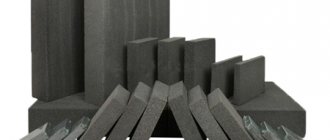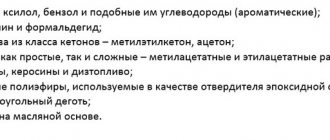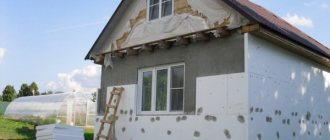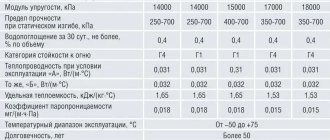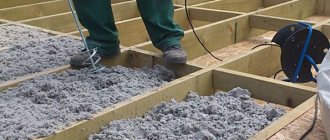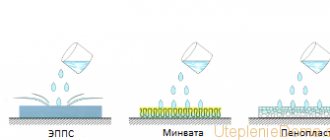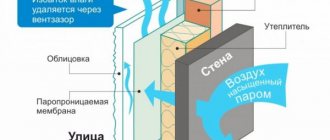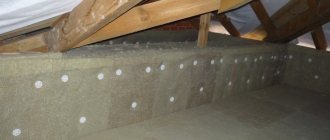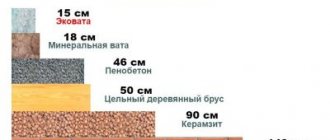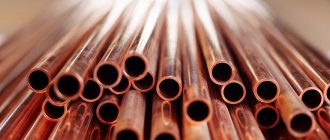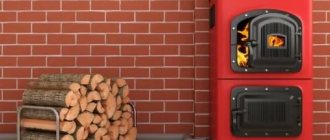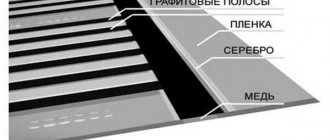- Scope of application of borax
- Use in medicine
In previous articles and (Long Read) reviews, we have talked more than once about what ecowool is, what it consists of, and what properties it has. Haven't you read it? Follow the links to materials on topics popular among civil engineers and private individuals, namely:
- ecowool versus liquid foam (penoizol);
- ecowool or polyurethane foam (abbreviated PU);
- Ecowool or basalt insulation – which is better?
Open the comparison table. Find out how a wood-fiber backfill thermal insulation product is superior to its analogues in thermal conductivity 1* and 2*, sound absorption (GHz), shrinkage, moisture resistance, and other technical characteristics. Visit our channel on the YouTube media service. Take a few minutes of your undoubtedly invaluable time to watch informative videos on construction, insulation, and reconstruction. From today's article you will learn about the ingredients in an environmentally friendly heater that, contrary to myths and misconceptions, do not cause the slightest harm to human health.
1* unit of thermal conductivity [W/(m K)] = 0.860420650096 thermal kilocalories per hour (60 min.) per meter (100 cm.) and 1℃ Celsius.
2* thermal conductivity of materials – study guide (download in PDF format)
Description of insulation
Ecowool is a loose thermal insulation material that consists of 90% cellulose and includes various antiseptic components and fire retardants. Due to the mineral salt contained in ecowool, it has excellent antifungal and antiseptic properties. Good performance characteristics are largely ensured due to the presence of cellulose in the insulation, which is an environmentally friendly material that is resistant to moisture and fire.
Ecowool is produced using a special technology by processing waste paper with waste from the paper industry. The use of completely natural ingredients ensures that this material is completely environmentally friendly and completely safe for humans. Due to its porous, loose structure, the insulator provides excellent insulation of the house and is an excellent alternative to insulation materials such as polystyrene foam and mineral wool.
The excellent efficiency of this heat insulator and the versatility of its use make it possible to insulate houses with ecowool in private buildings built from wood, brick and foam blocks. Thanks to the affordable cost of ecowool and the ability to do all the work yourself, the homeowner’s home renovation costs are significantly reduced.
Low strength and low rigidity
One of the disadvantages of ecowool is the presence of moisture in the insulation when it is applied to the surface using the adhesive method. Moisture can negatively affect the insulated surface, therefore, before starting finishing work, it is necessary to dry the layer for some time.
Tips for installing ecowool using the glue-wet method:
- Complete drying must be coordinated with other construction work.
- It is advisable to carry out the work in the spring or summer, when it is warm.
- You need to choose the right surface on which the ecowool will be placed. It is not recommended to use materials that are poorly permeable to moisture, such as lining.
Application of ecowool
Due to its properties, ecowool quickly became popular in construction. Its performance characteristics allow it to be used for private and industrial buildings.
Its main purpose is insulation and sound insulation in rooms. Installation can be carried out on any floor of the building, basement and roof floors, as well as light frame structures can be insulated.
If necessary, it can be used to reconstruct old buildings. This material, among other things, is useful in creating heat-insulating surfaces.
The fire retardants included in its composition contribute to fire resistance, so it is used in the manufacture of products that must have high temperatures.
Sound insulation is carried out both between floors and in adjacent rooms. It can be used as soundproofing plaster. When creating a room where there should be no echo (music studios or clubs), ecowool will also be useful. It is also used as an additive in bitumen-asphalt mixtures.
The wide range of applications of cellulose insulation is increasingly forcing builders to think about purchasing ecowool and, accordingly, about its price. The price of ecowool varies from city to city. Thus, the pricing policy depends on many factors and covers the price range for a bag of ecowool from 400 to 1500 rubles.
Frame insulation technology
Thermal insulation of a frame house is carried out using a dry or wet method. For application to walls, it is better to choose a “wet” technology; for floor insulation, a “dry” method is suitable.
Equipment for blowing ecowool
High-quality insulation of vertical surfaces is impossible without the use of specialized blow molding installations for installing ecowool. There are many different models on the market, differing in power, completeness and scope of application. Equipment for ecowool can be designed for both dry and wet methods.
Some craftsmen make the unit with their own hands. To make a blowing installation with your own hands, you need to understand the principle of constructing the equipment. Required working nodes:
- Platform. A frame for fixing a loading funnel with a motor, a blower, a sluice and a gearbox.
- Engine. Use a two- or three-stage motor.
- Gateway. Provides cotton wool capture and air dosage. Inside the chamber, the material is turned over and fed into the hose under pressure.
- Gearbox. Increases power output by reducing the speed of the ripper and motor.
- Baking powder. A system of knives like in a blender for fluffing and preparing the mass.
- Loading funnel for laying insulation.
- Control Panel.
The described complete set corresponds to the dry spray unit. To implement the wet-glue method, you will need a block for moistening the cellulose briquette.
Thermal insulation of the house: wet method
The technology is great for application to open areas. The method allows you to control the uniformity of laying and ensures a high density of the thermal insulation layer. Cellulose wool is fed under pressure and adheres to the surface. High adhesion is ensured by lignin - it is released when water is added to ecowool.
Work progress:
- Lath the walls.
- Fill the hopper with the fluffy mass.
- Start spraying. At the exit, dry cotton wool from the nozzle is moistened and supplied under pressure.
- Distribute ecowool evenly over the surface of the walls.
- Wait until it dries completely and cut off the excess - the waste can be reused.
Useful: Glazing of half-timbered frames from A to Z
“Dry” filling of wall space
The waterless method can be implemented on horizontal and inclined surfaces. Spraying is used to insulate closed cavities, non-demountable structures, and interfloor ceilings.
The essence of the method:
- At the top of the wall, make a hole commensurate with the dimensions of the insulation supply hose.
- Insert the sleeve and turn on the equipment.
- Fill the voids, periodically tamping the dry mass.
- Close and seal the hole.
Blowing into the cavity is carried out regardless of weather conditions and avoids the dismantling of structures. However, the technique has several significant drawbacks - it is difficult to ensure uniform distribution and the required thermal insulation density.
Manual filling of floors
The easiest way is to insulate the ceiling or floor. The technology does not require specialized equipment, but takes more time. The method is only suitable for thermal insulation of horizontal surfaces.
Do-it-yourself backfilling sequence:
- Level the surface, install the logs - the height of the boards is 8 cm, the approximate size of the cells is 40*80 cm.
- Fluff the compressed briquette well. Place the mixture in a large container and mix vigorously with a drill and mixer attachment.
- Fill the space between the joists with insulation. There should be an abundance of ecowool - a small pile of dry material will subsequently cover the floorboards.
Experts advise letting the cellulose wadding “settle.” The lignin included in its composition will react with moist air vapor and a dense crust will form on the surface of the insulation. The layer will improve heat retention.
Disadvantages of ecowool
Like any real-life material, ecowool has a number of disadvantages. Unfortunately, some illiterate “specialists” and unfriendly competitors are still trying to create a negative information background around promising material. Let's try to understand the accusations.
The most frequently mentioned disadvantages of insulation are the following.
Large volumetric shrinkage
When dry laying the material, especially when insulating vertical surfaces, shrinkage of up to 20% can actually occur. In this case, bare areas no longer effectively protect the building from frost, and so-called “cold bridges” arise.
It should be noted that most manufacturers suggest using a wet-glue method for insulating vertical walls, which reduces vertical shrinkage to 1% over the entire service life. For those who nevertheless chose the dry method, it is recommended to increase the laying rates by 20-25%.
High hygroscopicity
The material is capable of absorbing moisture from 10 to 15% of its volume. At the same time, the thermal conductivity of ecowool increases slightly. However, compared to glass wool, the thermal insulation properties of which decrease several times when moistened, the deterioration in thermal insulation is simply insignificant. In addition, it is compensated by the unique property of ecowool: when the temperature rises or air humidity decreases, i.e. when the dew point shifts, the fibers begin to actively evaporate the accumulated moisture and the original value of the thermal conductivity coefficient is restored. This allows the material to be used as a kind of moisture stabilizer. After all, low humidity is no less harmful to humans than high humidity. In addition, with proper vapor and waterproofing and ventilation of air gaps, the effect is minimized, and this drawback does not look so terrible.
Expensive equipment
Professional spraying equipment really costs hundreds of thousands of rubles. However, household-grade models that are quite capable of insulating a private home cost from 20 thousand. If a home craftsman is not embarrassed by a screwdriver that costs 9 thousand rubles, then an entry-level device will also fit into the construction budget. In addition, when laying by machine, the consumption of ecowool per square meter of surface is significantly reduced, the filling of cavities and the uniformity of injection are increased. This results in minimizing possible shrinkage.
High qualification requirements
When working on a professional unit, both special training and experience are really necessary. Unevenly laid fibers will not provide the calculated level of thermal insulation. You can master a household-grade device much faster. Before you start insulating your home, it would be wise to practice and get your hands on auxiliary buildings - a bathhouse or a garage.
Long drying when applied wet
There is nothing to argue with here - you will have to wait 2-3 days for complete drying. This period is not always acceptable, especially during repairs. During construction, you can always use this pause to carry out other work.
Low stiffness and strength
Compared to expanded polystyrene and dense basalt wool, ecowool is really fragile. This does not allow it to be used for insulating flat roofs, the insulation on which must withstand high loads, including snow.
Insufficient heat resistance
Ecowool can resist open fire, but with prolonged exposure to high temperatures, the fibers change their structure and begin to crumble and even slowly smolder. This does not allow the material to compete with basalt wool or vermiculite in the thermal insulation of stoves and chimneys.
Consequences and harm to health
This already falls into the category of outright fiction. Ecowool is the most environmentally friendly and least harmful to health insulation; it does not cause allergies or provoke the development of cancer. Ecowool can even be swallowed in small quantities, which cannot be said about, say, glass wool. Of course, during installation, especially in a dry manner, you should protect your respiratory system from dust by wearing a respirator.
To summarize, we can say with confidence: if you use ecowool in accordance with the manufacturers’ recommendations and strictly follow the technology, the balance of pros and cons will be in favor of the progressive material.
Properties of ecowool.
Excellent thermal protection, environmental friendliness and manufacturability of ecowool are the most important properties of this material. If you had only them, ecowool could already be recommended as an excellent replacement for many other insulation materials that are more familiar to us. So, if we compare ecowool with other alternatives, such as mineral wool, expanded polystyrene or slag wool, then in terms of thermal conductivity, it is on the same level with them, and despite the fact that it is more environmentally friendly.
However, this material also has much more obvious advantages that set it apart from other insulation materials. For example, the ability of ecowool to absorb and then evaporate moisture. Moreover, if we compare it with mineral wool, which also has this property, ecowool, in the process of saturation with moisture, does not change the thermal conductivity and other physical characteristics. Even with 30% moisture saturation, ecowool can lose only 3% of its properties. At the same time, during the process of drying, moisture gradually evaporates from the material.
What does it mean?
There are many things, but the most important thing is that if you use ecowool in a wooden house, it will become a natural regulator of the microclimate in the room; if necessary, it will take excess moisture from the air, and when the humidity decreases, it will release it. In other words, in wooden house construction, ecowool turns out to be an irreplaceable material, working not only as insulation, but also as a humidity regulator in the house.
Ecowool also has excellent soundproofing characteristics. The fact is that the fibers of the fine structure of ecowool are able to penetrate into the smallest recesses of the insulated space, creating an excellent soundproofing wall there. It’s not for nothing that the sound insulation indexes of ecowool are twice as high as those of mineral wool slabs. Accordingly, after installing ecowool, you should not take additional care of the sound insulation of the house.
Thus, we can say that ecowool actually creates an atmosphere of coziness and comfort in the house. And these are not empty words, despite the fact that ecowool is also fireproof and non-toxic. In fact, it does not ignite or melt, but only slowly smolders, as a result of which, without the influence of an external source of fire, the ecowool itself immediately extinguishes.
Thus, despite its woody nature, ecowool is a non-flammable material, which is confirmed by numerous tests of the material and received certificates.
How to make ecowool with your own hands, equipment and blowing of ecowool
Ecowool is one of the types of thermal insulation materials. This is a cellulose insulation that consists of an antiseptic and recycled cellulose. Cellulose fibers make up almost 80% of the material itself. It creates an excellent homogeneous seamless layer of insulation. What is ecowool insulation, reviews about it - we will talk about this in our article.
Definition of ecowool. Its advantages
Ecowool consists of fibers that contain lignin, a substance that, when moistened, imparts stickiness. This material is completely harmless and absolutely non-toxic.
In addition, all its components are non-volatile, which means that they cannot harm the environment and people.
There are other advantages:
- good thermal insulation and sound insulation material;
- not susceptible to rotting and fungus;
- in the event of a fire, it is not susceptible to fire for a long time;
- trouble-free installation;
It should be noted that in ecowool, as in all thermal insulation materials, rodents appear that consider it as their food.
This material contains substances such as boric acid and borax. They reduce the fire hazard and provide good protection against fungi and rot. The low cost of wool is associated with simple installation and inexpensive raw materials from which it is made.
Do-it-yourself ecowool. Laying methods
Ecowool can be installed by both professionals and amateurs. There are the following installation methods:
Blowing ecowool with your own hands confronts a person with certain problems. This method is used to insulate floors and flows. Ecowool is easy to install with your own hands; no special equipment or special skills are required.
Manual installation includes several stages.
First you need to prepare the insulation by pouring it into a container such as a bucket or basin. The next stage, “fluffing,” is carried out using a drill.
Blowing ecowool with your own hands requires direct manual installation, which consists of filling it into the ceilings. But there are situations in which additional blow molding equipment is required. After filling the insulation, it must be closed. To do this, you can use sheet materials, for example, plywood.
With the mechanized laying method, equipment specially designed for this is used. And wet-glue processing is usually carried out by professionals.
It is the last method that is of the highest quality.
Having considered what ecowool is with your own hands, the equipment that is used in this process is also worth considering:
- blowing installation - necessary for uniform supply of insulation;
- corrugated hoses - supply ecowool to the place of insulation;
- pump set;
- special nozzles for blowing.
This equipment is necessary when it comes to mechanized insulation of a building.
Recommendations for do-it-yourself insulation
Using ecowool, you can insulate your walls yourself. floors, ceilings, attics and roofs. On construction sites you can find out more specifically what ecowool insulation is, reviews about this process and recommendations.
But we will give some basic recommendations in our article:
To determine the density, it is necessary to take into account the material consumption
It is important to know that when insulating with your own hands, the material consumption is much higher than with mechanized insulation. Density control can be calculated using a formula and thereby reduce material consumption. To insulate different floors, there are standards for the thickness of the floor. The thickness of the ceiling for the floor is 15-20 cm, for attic floors - up to 30 cm, the thickness of the ceilings between floors is 15-20 cm. If the ecowool insulation process is carried out manually, then it must be taken into account that the material consumption may be slightly higher than originally envisaged. When insulating materials such as concrete, brick or iron with ecowool, it is necessary to prevent the possibility of the ecowool absorbing condensed moisture. Likewise, when insulating a roof, it is imperative to protect the insulation from penetration of sub-roof condensate. This can affect not only the quality of the building's thermal insulation, but can lead to gradual destruction. This thermal insulation material is excellent for insulating residential buildings and utility rooms, as well as for insulating individual building elements.
This can affect not only the quality of the building's thermal insulation, but can lead to gradual destruction. This thermal insulation material is excellent for insulating residential buildings and utility rooms, as well as for insulating individual building elements.
Durability, fire safety, preservation of properties
The durability of ecowool is almost equal to the durability of its main component – cellulose fibers. As for the antiseptic and fire retardant in its composition, their properties change over time. This is especially true for fire safety. Ecowool does not burn, but is prone to smoldering when heated - it is advisable to install it under other coatings.
Test for flammability of insulation materials
The thermal insulation properties of ecowool practically do not change over time.
Advantages
When considering the pros and cons of ecowool, it is difficult for an ordinary buyer to separate reality from the myths propagated by the marketing services of manufacturers.
Reality
Ecowool has the following advantages:
good level of thermal protection. Not excellent, as many publications claim, but sufficient for insulating various structures of a house or apartment - approximately at the level of mineral wool and polystyrene foam; durability. Insulation manufacturers claim a 50-year service life. The given figure cannot be verified on the territory of Russia due to the short period of application
In Finland and Canada, many houses built more than 70 years ago have such insulation; the absence of connecting seams is an important advantage over other types of thermal insulation materials. Even under conditions of the most complex surface geometry, cellulose fibers fill all cavities and cracks, eliminating the appearance of cold bridges; good sound insulation properties
Slightly lower than basalt wool, but higher than most types of insulation; fire safety - does not ignite when exposed to an open flame;
- ability to retain heat when wet. For example, glass wool, which has absorbed only 1% of water, increases the thermal conductivity coefficient by 8-9%, ecowool, when wet by 25%, increases thermal conductivity by 2-5%;
- vapor permeability - walls under such insulation “breathe”;
- good adhesion to all types of building materials, especially when working wet;
- environmentally friendly, despite the presence of borax and boric acid in the composition;
- high resistance against microorganisms and rodents.
Myths
The marketing services of manufacturers and sellers are actively promoting advantages that do not exist at all or cannot be explained logically:
- low moisture permeability - in fact, insulation based on cellulose fiber perfectly absorbs water. Another thing is that it dries well without losing its properties;
- good absorption. This plus is generally difficult to comment on, since the word “absorption” refers to the ability of a substance to absorb moisture. It turns out that with mineral wool getting wet is a significant disadvantage, while with ecowool it is a plus;
- the ability of insulation to soundproof an apartment from the noise of a construction site, a plane taking off, or passing cars. This is not entirely true. The insulation protects against airborne noise at a fairly good level, but cannot damp out sound waves of the structural and shock type (these noises are well distributed by the ground and the building structure);
- ease of insulation. It is difficult to agree with such a statement, since the vertical and inclined layer of ecowool does not adhere to the base of the insulated surface. It is necessary either to attach a film to the sheathing and add insulation between it and the wall (roof), or to resort to the wet application method, which is not feasible without special equipment;
- quick implementation of thermal insulation - when working manually, it takes several days to insulate, for example, a roof. Using special equipment for applying fibers using the wet method, you have to wait 2-3 days until the thermal insulation layer dries;
- low cost of material. The budget price of insulation is the main mantra of manufacturers. But there are nuances here that are ignored: expensive installation technology (hiring a team of specialists makes the total cost of insulation work equal to that of basalt wool insulation, and in some cases even slightly higher); insulating ecowool with your own hands, instead of saving, leads to excessive consumption of material and a thicker layer of insulation, which, ultimately, again equalizes the cost of work with insulation with basalt fiber wool;
- the possibility of applying it over old insulation is a myth that is difficult to explain. For example, as the experts who proposed this insulation option see, the technology of thermal insulation work on the outside of the building (along the facade) or in the attic space.
Controversial point: the pros and cons of thermal insulation
Despite the good technical characteristics, insulating houses with ecowool is associated with some nuances. Let's evaluate the positive and negative aspects of using cellulose thermal insulation.
Advantages of eco-insulation
The main advantages of ecowool are:
- Absorption and evaporation. The material partially absorbs moisture, but at the same time retains its thermal insulation properties. With an increase in humidity by 25%, ecowool will lose up to 3-5% of its thermal efficiency.
- Seamless insulating layer. Blowing ecowool is possible in the most inaccessible places. A homogeneous mass fills all cracks and cavities without forming cold bridges.
- Environmentally friendly. The absence of harmful volatile compounds makes the insulation safe.
- Good sound insulation. Excellent noise absorption ability - a 15 mm layer suppresses 9 dB. Ecowool is often used to insulate recording studios, airports, and buildings near busy highways.
Useful: How to make a balcony in a frame house
An undeniable advantage is the relatively affordable cost. The approximate price of ecowool insulation is about 10 USD. per bag weighing 15 kg. However, it is worth considering that the total cost of thermal insulation will increase significantly due to the expensive technology of applying cotton wool.
Problems of using ecowool
The disadvantages of cellulose insulation include:
- Reduced thermal efficiency. Over time, thermal conductivity increases. The deterioration of thermal insulation properties is due to a decrease in the volume of the material and saturation with moisture. To maximize heat retention, it is necessary to ensure ventilation of the insulation and laying a layer of insulation with a reserve.
- Shrinkage. The problem is typical for vertical structures. To avoid the appearance of voids, it is necessary to apply cotton wool in a dense layer - at least 65 kg / cubic meter. m.
- Difficulties in installing ecowool. Achieving the required density and uniform distribution is possible only with the use of special machines for blowing ecowool.
- Low rigidity. Cellulose insulation, unlike slab materials (expanded polystyrene, basalt mats), cannot be installed using the frameless method.
Ecowool should not be placed near chimneys , fireplace pipes, or open fire sources. The insulation requires additional protection - this can be basalt foil mats or asbestos-cement slabs.
It should be noted that the quality of thermal insulation does not always meet the standards. The name of the manufacturer influences how much ecowool costs. Little-known companies, in an effort to save money, replace borax and borax with cheap flame retardant analogues. Insulation with ammonium sulfates and boric acid quickly loses its fire-fighting properties.
What is ecowool?
A developer who wants to insulate his home knows firsthand what ecowool is. Waste paper, cardboard, and corrugated paper are broken down using special equipment, preserving their fibrous and elasticity.
The basis of the technology is a unique sprayer for separating cellulose fibers. Spraying is carried out under the influence of air flow.
The mass foams and is filled with natural antiseptic additives. Two types of installations for ecowool are produced: stationary equipment, as well as a mini-processing plant.
NPO Parmatekh sells special equipment for the production of cotton wool at home. A stationary cellulose processing line is installed in the premises. Producing ecowool with your own hands does not require additional investments.
Crushed wood fibers make up 80% of the mass, the remaining 20% are additional antiseptic additives that improve the quality of the product. A composition is used for impregnation that will prevent ignition and infection by mold fungi.
From destruction by insects or rodents, the mass is impregnated with borax (an antiseptic). Cellulose wool is an environmentally friendly product - at elevated temperatures of +400°C, emissions are 15 times lower than the permissible norm.
Small grained wood fibers form a crust under the influence of moisture, which prevents air from penetrating into the insulation. The ability to “breathe” helps conduct steam to the surface of the insulation without accumulating inside.
Ecowool insulation is performed in the following ways:
- for dry filling – dry component;
- in rooms with minimal requirements for decorative cladding - a sprayed product in the form of a water-adhesive solution;
- stabilized - used with minimal consumption for dry installation and wet spraying;
- in residential premises and public places, an insulating mass impregnated with oil is used for spraying (which significantly reduces the release of dust particles during work).
The new type of insulation takes the form of panels that are laid without the use of a blow molding machine. This type is widely used by builders for insulating private houses. Installation does not require special devices.
"ECO-WOOL-777" —
ECO-WOOL INSULATION: QUESTIONS AND ANSWERS.
1. IS ECO-WOOL AN ECO-FRIENDLY MATERIAL?
WHAT ABOUT THE LEAD IN PRINTING INK?
I WOULD LIKE TO UNDERSTAND: ARE BOROX AND BORIC ACID DANGEROUS TO HEALTH OR NOT?
IF ECO-WOOL IS AFRAID OF MICE, MAYBE IT IS NOT SAFE FOR HUMANS?
DOES ECO WOOL CAUSE ALLERGIES?
So, what is Ecowool?
Ecowool is an ecological heat and sound insulation insulation made from waste paper processed in a special way with the addition of borax and boric acid compounds. Outwardly it is a crumbly gray mass.
Ecowool is considered one of the most environmentally friendly materials because it does not contain any phenolic compounds. Compounds of borax and boric acid are not volatile substances that rise into the air and, moreover, pass through the pie of the structure in which the ecowool is closed. You can inhale vapors, but there are none. Do not forget that borax and boric acid are used in medicine and are sold freely. Therefore, the harm from ecowool is a myth.
Rodents do not settle in ecowool due to the addition of boron compounds. Not because they are poisonous, but because the respiratory tract of rodents is irritated and clogged and, accordingly, they cannot live in ecowool. In addition, due to the loose nature of the material, it is impossible for a rodent to get into the material and make holes in it.
The fire-fighting properties of ecowool are due to the presence of fire retardants (boric acid salts) in it. That is, when exposed to fire, an ash-colored crust forms on the surface of ecowool, preventing the flow of air, which does not melt or crumble. And thanks to the presence of borax in the composition, self-extinguishing occurs - this effectively slows down the progress of the fire. Ecowool does not burn or melt, but only slowly chars and, most importantly, ecowool does not emit toxic gases and can go out on its own if the source of ignition is eliminated. These properties of ecowool help save lives and property in case of fire.
In addition, borax and boric acid are antiseptics, so ecowool protects building materials in contact with the insulation from destruction by microorganisms, protects against rotting and fungal growth.
About twenty years ago, the printing house actually used lead in casting machines in quantities dangerous to the health of printers. Nowadays, in the production of newspapers and magazines, a different technology is used - computer technology; only non-toxic types of paints are used, which also undergo thorough testing and certification. Therefore, the presence of lead in ecowool is a myth, unless lead got into ecowool in some other way.
Our company is a representative and contractor of two time-tested factories - DPK and Equator.
2. WHY DO INSTALLERS WEAR SPECIAL CLOTHING WHEN PERFORMING INSTALLATION WORK WITH ECO WOOL?
Qualified installers perform ecowool insulation in special clothing, directly using dust respirators and suits that protect their respiratory tract and clothing from fine dust that inevitably appears during work. In addition, they work with fluffy material almost every day, and you insulate your house once, and the ecowool is in a closed state in it.
3. QUESTION ABOUT EQUIPMENT FOR BLOWING CELLULOSE ECO WOOL. IT IS DIFFERENT FOR INSTALLERS, CAN THIS MEAN THAT THE RESULTS OF INSULATION CAN DEPEND ON ONE EQUIPMENT OR ANOTHER?
The most important thing is that the installation must be professional and it doesn’t matter what it looks like, what color or shape. All professional installations are equipped with one type of air turbines (to create the optimal density of Ecowool there should be two of them). Unfortunately, we do not yet produce such turbines and almost all professional equipment is imported. However, do not forget that the result of the work largely depends on who does the work, on the qualifications and experience of the workers.
4. IS ECO WOOL AFRAID OF MOISTURE?
Ecowool is afraid of direct exposure to water, for example, if you pour water from a bucket on it. However, what is very important, it does not lose its properties when the fibers are saturated with steam moisture. The insulation dries like newsprint, without losing its thermal insulation properties.
Since Ecowool is vapor permeable, it can be used without vapor protection. But here, as always, you need to take into account its proximity to other materials in the design. Vapor barriers are used to protect walls and insulation. Vapor barrier materials prevent the passage of steam into the insulation and enclosing structures and keep the “pie” from getting wet. Thus, couples should leave the house and not get inside it.
5. WHY IS ECO WOOL CALLED “BREATHABLE” INSULATION? HOW DOES SHE “BREATHE”?
Ecowool, like wood, has a capillary structure. The capillaries that are located in the insulation allow moisture not to accumulate inside, but to be forced out. Thus, the insulation “breathes” in the same way as buildings made of natural wood.
6. WHAT IS THE BEST STYLING METHOD? DRY OR WET?
When answering the question which method is better - dry or wet, you need to immediately clarify: technologically, the wet (wet-glue) method is used only in vertical structures or on the ceiling and at above-zero temperatures outside.
The properties of the insulation are preserved using any method.
7. DOES ECO WOOL SHRINK?
Indeed, shrinkage is possible over time, because all builders know that even wooden houses shrink. But here’s the thing: if specialists do the insulation, then from experience they take into account the places where shrinkage of the insulation is possible and, when blowing, set an increased density in these places by increasing the force of air flow.
In addition, the recommended density of ecowool in various structural elements must be observed precisely for this purpose, which is why professional equipment is needed when performing work.
The density of ecowool insulation depends on the manufacturer and the fraction of the material. Recommended densities when performing ecowool insulation work (material, Donskoy, Tula region):
The open method of insulation is 35 kg/m3, closed loop, inclined surfaces - 45 kg/m3, vertical structures - 60 kg/m3.
Quite recently, on one well-known forum, a question was asked about wall insulation and the required density. Some so-called experts said that there is no need to increase the weight of the structure to 60 kg/m3, that a density of 50 kg/m3 is quite enough. Someone suggested using only the wet method.
Let's take it in order. If you pump ecowool with a density of 50 kg/m3 and 60 kg/m3, then the Customer may not notice the difference with the naked eye, he will be pleased with the savings. But over time, when the material begins to compact under its own weight, the density will play a role in shrinkage. Therefore, the advice is not to save, but to comply with the technology and the required insulation density parameters in everything.
As for the use of the wet method, it is indeed technologically recommended to use it in vertical structures. Because when wetted, Ecowool, due to the lignin present in it, adheres tightly to the surface. For example, we all remember shooting paper from tubes as children. However, in practice, not everyone is ready to use it in their homes, primarily due to the high cost (it is almost 2 times more expensive than dry) and then because of the need to dry the material for some time. This still requires weather, the absence of high humidity in the air. In addition, insulation using the wet method can be done at air temperatures above 5 degrees, since water is used.
Our company recommends that Customers use a combined insulation method for vertical structures - combining a small layer of wet-adhesive application and a dry one. In practice it looks like this.
The wet-glue method is the same wet method, only glue is added to a barrel of water in a certain proportion. Since Ecowool is applied in this way in a small thickness, the glue promotes greater adhesion and faster drying, displacing water. An uneven surface is created, which subsequently allows the dry ecowool, filled into the remaining cavity under pressure, to be further prevented from further subsidence.
The customer receives quite a lot of advantages here.
Firstly, savings on the wet method. Secondly, the material is practically non-shrinkable in the future. Thirdly, application using the wet-glue method occurs on an open surface and the specialist sees all blind spots and crevices.
As for blind spots, there is only one thing I can recommend. Everyone builds their own house in their own way; the design of houses is individual. People read the Internet, watch videos and prepare their project, saving on the cost of visiting a specialist. This is the most common mistake. In any business you need to follow technology. We don’t buy a window first and then call a specialist to install it. The same is the case with Ecowool insulation. A specialist who will come for an inspection before insulation will tell you how to properly leave access for pumping material, what materials are best to use, where there are blind spots and obstacles. After all, the specialists who come to insulate the prepared structure do not have X-ray vision.
I would like to clarify that the visit of a specialist is his work, which of course is paid, but in our company the cost of the visit upon further concluding a contract for the performance of work is deducted from the cost of the contract.
8. WHAT KIND OF ECO WOOL IS A SOUND INSULER?
During installation, ecowool insulation fills any, even the smallest, recesses and crevices. At the same time, as they fluff up, the fibers intertwine with each other, forming a sound-proofing layer that absorbs sound waves well. The absence of gaps, joints and voids prevents the further propagation of sound waves.
Therefore, ecowool material is often used in film studios, filling podiums.
9. IS IT POSSIBLE TO INSULATE A HOUSE WITH ECO-WOOL?
In principle, of course, you can insulate it yourself, following the technology.
And again we return to technology.
The main thing is to maintain the density of the material in the structure. It is very difficult to independently fluff the material to such a state as the equipment does. Therefore, the consumption of material when applied independently will be greater and, accordingly, another 15-20% must be added to the calculated amount of material.
During the filling process, the heat insulation is compacted by hand; practice is also needed here; the insulation should feel like an elastic spring to the touch.
The independent insulation process becomes labor-intensive and slow, so it is, as a rule, interesting only for small insulation areas.
10. IS IT BETTER TO INSULATE A HOUSE OUTSIDE OR INSIDE?
Each house is individual and built from different materials. Some insulate a house made of logs from the inside, then the outer walls will delight you with their natural appearance, while others do the opposite. A wooden house can be insulated with ecowool both outside and inside. Customers often believe that internal insulation reduces the interior space of the home. Therefore, in this case, the choice is up to the client.
11. WHAT IS ECO WOOL BETTER THAN OTHER INSULATIONS?
There is a lot of data on the Internet related to ecowool; this topic is often discussed on forums. But you will get the most reliable answer to this question from people who have already used ecowool for their home and have experienced, so to speak, the advantages of this method of home insulation for themselves.
I would like to add that ecowool is most often used to insulate a house in the construction of which wood materials were used. Ecowool is exactly what you need here! – after all, cellulose is made from wood, which means that a wooden house is insulated with “wood”, what more can be said!
Ecowool insulation is seamless, there are no so-called cold bridges. Ecowool blocks air movement and draft.
In addition, Ecowool is in demand for repairs and reconstruction of buildings that are already in use, when additional insulation of the structure is required without dismantling it. For example, technological seams in panel buildings or brick houses. In addition, during further operation of the insulated house, if the material subsides for one reason or another, ecowool can always be added or pumped to the top point. This is the only repairable insulation.
Do not forget about the environmental friendliness of Ecowool, which does not contain any formaldehyde.
Installation of ecowool is waste-free; only as much material is used as needed.
12. WHY DO WE NOT RECOMMEND INSULATING A WOODEN HOUSE WITH POLYURETHANE FOAM?
Any material has its own areas of application. Polyurethane foam and ecowool are completely different materials in their structure and composition. Over time, the polyurethane foam will definitely move away from the wood and therefore cold bridges may occur.
In addition, polyurethane foam components contain phenol, which is considered a toxic substance because it emits toxic fumes, and this process can continue for years without reducing or losing toxicity. This chemical element can cause disruption of the most important systems of the human body: respiratory, nervous, cardiovascular. Draw your own conclusions.
13. WHAT WARRANTY DO YOU PROVIDE FOR YOUR INSULATION?
We have never come across insulation that has a warranty stated. There are properties of insulation such as thermal conductivity, fire resistance and others - these are some specific numbers. Simply, by its nature, insulation does not have a set service life. The service life of insulation will largely depend on how correctly it is laid, mounted and protected.
Our company provides a guarantee only for installation work, i.e. on the process of laying thermal insulation. This means that during the warranty period, if the material shrinks or the customer discovers under-insulated areas, we eliminate this defect.
14. TELL ME WHICH ECO WOOL TO CHOOSE, IF THERE ARE MANY MANUFACTURERS OF THE MATERIAL. HOW TO DECIDE?
In the insulation market, there is only one insulation and it is called “ecowool”, but there are many different brands of it from manufacturers, for example, Extra, biowool, etc. It is important to understand that insulation may have different brand names, but the raw material of ecowool is always the same - this paper. However, here we must not forget about the quality of the material produced. Ecowool must be produced industrially, in factory conditions, in compliance with the necessary requirements for waste paper, the additives themselves and the mechanical supply of additives. Often, replacing additives with cheaper ones leads to the fact that over time, the smell of urea from the material begins to appear and borates begin to crumble, which leads to the loss of ecowool properties. As a result, there is talk about mice and rodents.
15. REASONS FOR NEGATIVE REVIEWS ABOUT ECO WOOL.
Often the reason for negative reviews about ecowool insulation is poor-quality installation, which leads to shrinkage of the material, non-compliance with insulation technology and underestimation of the density of ecowool in the structure.
As has already been said, installers are not X-rays and it is quite difficult to read a closed frame, hence the lack of the ability to fully control the blowing process. As a result, there is a high probability of formation of areas with low blowing density.
Another mistake (or attempt to save money) is the use of amateur equipment. Such installations are, in principle, unable to create the necessary air flow pressure sufficient for blowing with the required density.
And finally, the pursuit of savings at the expense of quality, when people look for cheaper materials or work, without taking into account many features when choosing, which necessarily affects the result.
Often, the material is cheaper - this means that the components are becoming cheaper, the technology is being violated, hence rodents and other issues that we have already considered.
By choosing cheaper work, we also often end up with poor-quality installation and incorrect calculation of materials for insulation. After all, the performer must somehow compensate for his expenses and still earn money.
We all forget that free cheese is only in a mousetrap.
____________________________________________________________________
In conclusion, I want to say that ECO WOOL is an environmentally friendly, affordable material. This is an excellent alternative to widely used insulation materials. Using Ecowool insulation, you can quickly and, most importantly, efficiently, insulate your home in the shortest possible time. The cost of such insulation (if we take into account the total cost: work + material) is often cheaper than traditional insulation.
Material overview
What is ecowool?
Ecowool (another name for this substance is “cellulose wool”) is a loose thermal insulation material of light gray or brownish color.
The composition of cellulose wool includes the following components:
Enlarged photo of the material
- 81% – recycled cellulose. Most often, recycled waste paper is used to obtain this component; waste from wood processing enterprises is used a little less often.
- 12% – boric acid. Performs antiseptic functions and prevents the development of colonies of cellulose-degrading bacteria in the thickness of the heat-insulating layer.
- 7% - borax. This component is responsible for the fire safety of the insulation, since it is a fairly active fire retardant.
When the material is moistened, free lignin is activated, which gives the cellulose fibers the necessary adhesiveness. Thanks to this composition, cellulose wool is one of the most environmentally friendly thermal insulation materials, since it contains virtually no volatile chemicals, phenols, heavy metals and other toxins.
As a rule, this material is ordered from the same companies that insulate houses. However, for self-installation you can purchase pressed ecowool in briquettes.
Advantages
Despite its not very long history (in the Russian Federation, ecowool began to be actively used only in the early 90s), this material has already gained quite noticeable popularity.
The reason for this is its obvious advantages:
- Environmentally friendly. As we noted above, cellulose loose insulation does not contain substances that are potentially dangerous to humans. Wall insulation with ecowool can be done in any room, including bedrooms and children's rooms.
- High performance characteristics. The cellulose mass has sufficient porosity and low thermal conductivity. As calculations by heating engineers show, a layer of ecowool 150 mm thick is equivalent in energy saving quality to masonry 4.5 bricks thick.
The range of applications is very wide
Low chemical activity
Where ecowool is in contact with metal parts of the building frame or fasteners, corrosion processes are not observed. This is especially important when using cellulose pulp to insulate a loggia with metal parts of the parapet (for more details, see the article How to insulate a loggia and what is required for this).
Soundproofing characteristics
The fibrous structure of the material, which includes segments oriented in different planes, provides a high level of noise absorption (a 50 mm thick insulator reduces the volume of transmitted sound by at least 60-65 dB).
Vapor permeability and resistance to moisture. These characteristics reliably protect the insulation layer from internal condensation, therefore, even if there are problems with the internal ventilation of the building, the thermal insulation layer does not get wet.
Flammability test
Other advantages of cellulose wool include bacterial resistance (due to the action of boric acid), as well as fire safety. Even when exposed to an open flame, the insulation does not ignite, but begins to smolder, and when the external heat is removed, it dies out in a matter of minutes.
Flaws
Against the backdrop of such an impressive list of advantages, the disadvantages of this material do not seem critical.
Still, they are worth mentioning:
The main disadvantage is the inability to carry out independent installation. To “blow” ecowool into a design, special equipment is almost always used, so installing this heat insulator with your own hands will be problematic.
- The insulation process is accompanied by the formation of a large amount of dust from microparticles of cellulose and borax.
- When installation is carried out using the “wet method”, further finishing of the room can be carried out no earlier than a day later. This is due to the rather long drying of cellulose.
- Despite its heat resistance, it is still not worth using cellulose fiber to insulate chimneys, fireplaces and similar structures.
- The fairly high price is another minus. The cost of ecowool insulation is several times higher than the cost of thermal insulation using, for example, mineral wool or polystyrene panels. However, the end result is worth the investment.
As you can see, with the right approach, most of these shortcomings can be leveled out. So if you want to insulate your house, attic or garage with ecowool, then you can safely do it without fear of consequences.
Lack of uniform GOST requirements for products
Very often, ecowool is evaluated not by its potential capabilities, but by the manufacturer who produces it. It is unscrupulous manufacturers who spoil the image of this material.
The lack of uniform standards and legislative requirements for release creates many loopholes that are used to release material that does not meet the declared characteristics. Ecowool's fire-prevention, insulating, antibacterial and structural properties are negatively affected by savings on the most important components of the raw material - borates.
Until ecowool is subjected to uniform standardization, consumers are left with either purchasing the product at random, or following these recommendations when purchasing cellulose insulation:
- Collect as much information as possible about the company that produces ecowool. Such information can easily be found on construction forums - many participants devote more than one topic to this, praising some and leaving negative reviews for others. You can draw your own conclusions based on the experiences of other buyers.
- It is important to visually examine the material before purchasing. The appearance of ecowool should resemble fluff, there should be no large impurities and fractions, there should not be a feeling that you are taking shredded paper or dust
- Ecowool must have good fire-fighting characteristics. When exposed to an open fire, the cotton wool should smolder slowly and immediately extinguish in the absence of contact with fire
- The structural integrity of the packaging should not be compromised; ecowool should not be damp to the touch
- High-quality ecowool has a grayish tint; deviations towards a light or yellow color are unacceptable - there is a high probability that low-quality raw materials were used in production
- When shaking the ecowool, fine fractions in the form of sand should not appear. The presence of such means that a significant part of the boron components was incorrectly introduced into the structure of the material
Ecowool is a good insulation material for a house made of timber. But you shouldn’t stop there only, there are other types of insulation.
Ecowool can also become insulation for a frame house. And what type exactly is up to you to choose. If you need a frame house for permanent residence, then this article will help you in construction.
Ecowool or polyurethane foam: what to choose?
Hello, Daniil!
Insulation is undoubtedly one of the most important stages of construction, because the temperature inside the house directly depends on the quality of the insulation itself and the correctness of its installation; Also, high-quality insulation allows you to save a lot on heating costs. On the modern market, the most popular insulating materials are polyurethane and ecowool, but this does not mean that these products are similar to each other. Polyurethane foam and ecowool are fundamentally different insulation materials, therefore, in order to understand which one is better, you should consider each depending on the parameter.
Environmental Safety
The environmental friendliness of polyurethane foam is not just a fact - it is confirmed by many certificates of hygiene services. This insulator is highly resistant to various chemicals, which suggests a long service life of such insulation. These parameters are due to the fact that polyurethane, both simple and foamed, is completely inert to almost all chemicals, which means it does not decompose when interacting with them.
Such properties have made polyurethane foam a material used in the insulation of modern equipment (refrigerators, boilers, thermostats, medical devices that come into contact with drugs and the mucous membranes of human organs).
Ecowool is cellulose or paper, crushed into tiny fibers, with the addition of chemicals. Substances used to impregnate cellulose raw materials must have the following properties:
- Reduced flammability (fire retardants);
- Reduced ability to absorb moisture (hydrophobic);
- Repelling pests (poisons).
But despite the fact that cellulose insulation contains chemicals, it remains absolutely safe for humans.
Characteristics of polyurethane foam
Polyurethane foam is an insulator consisting of 5 - 10% binder, the rest of the insulation is gases and air. This insulator has the following characteristics:
- Density within 50 - 150 kg per m2;
- Thermal conductivity - 0.020 - 0.028;
- The pores of the material are closed;
- Temperature range - from -160 to +150 degrees;
- Service life - from 20 to 50 years.
The material is quite soft, easily deformed and does not lose its structure. It is worth noting that polyurethane foam can easily withstand bending, but quickly wears out when pressure is applied to it (the permissible reduction should be no more than 10%).
Polyurethane foam is valued for its low thermal conductivity, which means that only a 2 mm wide layer freezes or warms up. It follows from this that for high-quality thermal insulation you will need an insulator layer of 5 mm or more.
The polyurethane foam insulating layer will become stronger over time due to crystallization of the structure. This material does not mold, does not rot, is not digested by rodents and is not susceptible to fungus. But at the same time, polyurethane foam is a poor sound insulator and can be dangerous to humans; if absorbed, may cause volvulus.
Parameters of cellulose insulator
Ecowool is a product obtained by recycling paper with the addition of components that prevent combustion. The main properties of this material can be considered the following:
- Density: from 30 to 75 kg/m2;
- Thermal conductivity: 0.032 - 0.041;
- Low air permeability;
- Passivity to chemical influences;
- Good sound insulation parameters;
- Shrinkage susceptibility - 1.2%;
- Service life: from 5 to 10 years;
- Operating temperature: -40 to +120 degrees
In terms of density parameters, both insulators differ little, but the thermal conductivity of ecowool is higher, which means that the minimum insulator layer will be already 10 mm. It should be noted that at temperatures above -45 degrees the material begins to deteriorate.
This insulation cannot be used to insulate external surfaces.
There are a lot of manufacturers on the modern market who produce low-quality ecowool, violate technology, and produce products that do not comply with GOST standards, so you should be very careful when purchasing.
Composition and basic properties
The main stage of ecowool production consists of introducing specialized additives into the cellulose base. The following can be used as a basis:
- surplus raw materials in the production of corrugated containers and cardboard, as well as substandard products from such industries;
- waste paper – recycled assorted cellulose. It does not provide the required purity and uniformity, therefore, the quality of insulation made from such raw materials will be lower.
The percentage composition of ecowool is as follows:
- Paper base – 81%;
- Boric acid – 12%. During production, it is added to the base twice - the compound determines whether ecowool has such an important property as resistance to ignition, as well as the antiseptic and insecticidal qualities of the insulation;
- Borax – 7%. Sodium salt of boric acid is included in the composition in order to obtain non-flammable insulation.
Ecowool production technology was borrowed from Finland, where its production volumes are very large, and the share of ecowool in the market of thermal insulation materials in low-rise construction reaches 70%.
What does ecowool look like? The insulation is supplied in briquettes, and their contents are a crumbly, soft-to-touch substance of gray or almost white color.
For ease of packaging, the insulation is pre-compressed; if you remove it from the briquette and fluff it, the material will increase in volume by 3-4 times. Interestingly, the density of ecowool in packages may vary depending on the manufacturer.
Insulating the walls of a house with polystyrene foam: debunking the myths.
Features of the composition and production of ecowool make it possible to obtain a heat-insulating material that initially has the following characteristics:
- thermal conductivity coefficient is 0.037-0.042 W/mK, this means that only about 0.04 Watt of thermal energy will pass through 1 meter of insulation at a temperature difference of 1 Kelvin, this allows the heat generated by heating devices to remain inside the house;
- vapor permeability – 0.3 mg/(mhPa), the material is able to absorb wet steam from the room and, in the presence of ventilation, dry without forming condensation;
- air permeability is low, about 0.0001 cubic m/sq.mPa at a density of 40 kg/cub.m;
- flammability – moderate (G2), flammability – difficult to ignite (B1), smoke-forming ability – low (D1);
- sound absorption – 63 dB for every 50 mm of thickness;
- density - when laid, it ranges from 25 to 96 kg/cubic meter.
Are these values good or not? If we compare the main indicator - thermal conductivity, then ecowool and its competitors, some types of mineral wool and polystyrene foam, are approximately at the same level. But when giving preference to any material, they are also guided by considerations such as ease of installation or versatility, and for some, the amount of sound absorption or hygiene may come first.
Many years of experience in using ecowool in construction allows us to draw a number of conclusions about its operational features, both positive and negative.
The best ecowool: how to choose a manufacturer and check the quality
Any ecowool has the same composition. Therefore, if ecowool production technologies are followed and good equipment is used for this, then there is no particular difference between materials from different manufacturers. The quality can be affected by raw materials, storage method, delivery, etc. You can determine high-quality ecowool yourself. Here are a number of points to pay attention to when choosing insulation:
The equipment greatly influences the quality of ecowool
The color should be a uniform gray. There should not be any yellow or other shades in the form of inclusions. Their presence may indicate improper use of antiseptics and fire retardants. And also about uneven mixing of the material.
Ecowool should have no smell. This applies to both dry and moist material. If ammonium sulfate was used instead of boric acid and borax, then when such ecowool is moistened, an ammonia smell will appear. It is better to refuse to purchase such a product.
Related article:
Thermal insulation of the floor in the country house: options for insulation and materials
How much can the thermal insulation of the floor in the country house save? Insulation methods and materials.
The consistency of ecowool should be uniform and free of dust and large particles of paper. Since this means that the insulation was produced using poor equipment. And over time, such a product can shrink a lot.
The appearance of the heat insulator should be comparable to ordinary down. If you take a handful of material in your hand, it should not crumble, but remain in the form of a single lump.
The best ecowool should have a uniform consistency
In addition to paper, ecowool should contain boric acid and borax. In appearance they look a little like salt crystals. And if you crush a handful of ecowool in your hands, then the presence of these crystals on your hand will indicate the correct composition of the material.
Confirmation of product quality is ensured by the availability of certificates of compliance with fire safety and sanitary standards.
Helpful advice! The quality of ecowool is also checked by the method of setting it on fire; it should not burn, at most, in the presence of a constant source of fire, it should only smolder.
Well, an important factor influencing which ecowool to choose is brand awareness. World-famous companies or those that are very popular in their markets will always monitor the quality of their products. Below are a number of brands that have gained the trust of users both in their countries and abroad:
Popular ecowool manufacturers monitor the quality of their products
- Isofloc, Climacell, Steico (Germany);
- EkoVilla, Termex (Finland);
- Isofiber (Norway);
- ECOCELL, Greenfiber (USA);
- IGLOO Cellulose (Canada);
- Unisol (Ukraine);
- GreenWool, Nanovata, Equator (Russia).
